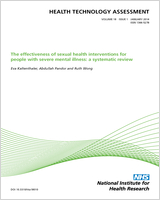Included under terms of UK Non-commercial Government License.
NCBI Bookshelf. A service of the National Library of Medicine, National Institutes of Health.
Clarke A, Pulikottil-Jacob R, Grove A, et al. Total hip replacement and surface replacement for the treatment of pain and disability resulting from end-stage arthritis of the hip (review of technology appraisal guidance 2 and 44): systematic review and economic evaluation. Southampton (UK): NIHR Journals Library; 2015 Jan. (Health Technology Assessment, No. 19.10.)

Total hip replacement and surface replacement for the treatment of pain and disability resulting from end-stage arthritis of the hip (review of technology appraisal guidance 2 and 44): systematic review and economic evaluation.
Show detailsDecision problem
This report aims to evaluate the clinical effectiveness and cost-effectiveness of THR and hip RS for the treatment of pain and disability in people with arthritis. More specifically, we aim to investigate, in people with pain and disability resulting from arthritis of the hip for whom non-surgical management has failed:
- the clinical effectiveness and cost-effectiveness of different types of elective primary THR compared with primary hip RS in those suitable for both procedures
- the clinical effectiveness and cost-effectiveness of different types of primary THR compared with each other in those not suitable for hip RS.
Overall aims and objectives
- To undertake a systematic review of the clinical effectiveness and cost-effectiveness of (a) different types of primary THR compared with RS for people in whom both procedures are suitable and (b) different types of primary THR compared with each other for people who are not suitable for hip RS and to investigate factors that influence benefits and costs. If data are sufficient, the influence of patient- and intervention-related factors on the magnitude of treatment effects will be explored through subgroup analysis and meta-regression.
- To further develop the cost-effectiveness and cost–utility models published in TA4425 using updated NJR data and model inputs when available.
- To report on findings and make recommendations for future research.
This report aims to evaluate the clinical effectiveness and cost-effectiveness of THR and RS for the treatment of pain and disability in people with arthritis [Table 7 provides a summary of the population, intervention, comparator/control and outcome (PICO)].
TABLE 7
Population, intervention, comparator/control and outcome table
- Definition of the decision problem - Total hip replacement and surface replaceme...Definition of the decision problem - Total hip replacement and surface replacement for the treatment of pain and disability resulting from end-stage arthritis of the hip (review of technology appraisal guidance 2 and 44): systematic review and economic evaluation
- Clinical effectiveness results - Levetiracetam as an alternative to phenytoin fo...Clinical effectiveness results - Levetiracetam as an alternative to phenytoin for second-line emergency treatment of children with convulsive status epilepticus: the EcLiPSE RCT
- Discussion - Levetiracetam as an alternative to phenytoin for second-line emerge...Discussion - Levetiracetam as an alternative to phenytoin for second-line emergency treatment of children with convulsive status epilepticus: the EcLiPSE RCT
- Mus musculus predicted gene 9222 (Gm9222), transcript variant 13, non-coding RNAMus musculus predicted gene 9222 (Gm9222), transcript variant 13, non-coding RNAgi|1845792405|ref|NR_168605.1|Nucleotide
- Mus musculus predicted gene 9222 (Gm9222), transcript variant 9, non-coding RNAMus musculus predicted gene 9222 (Gm9222), transcript variant 9, non-coding RNAgi|1845792094|ref|NR_168601.1|Nucleotide
Your browsing activity is empty.
Activity recording is turned off.
See more...